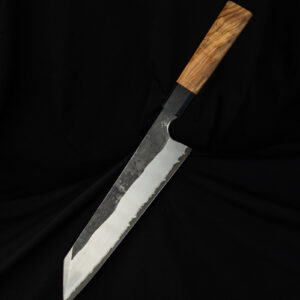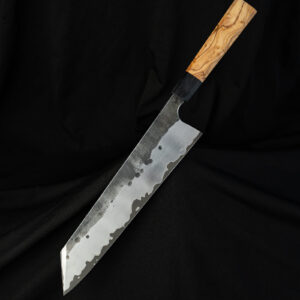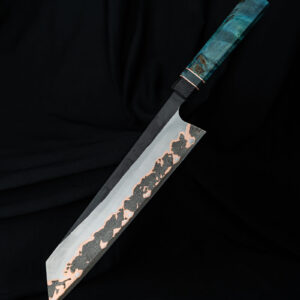Currently Empty: $0.00
0 Comments
Here are the key differences between a Gyuto and a Kiritsuke:
Blade Shape and Size
- Gyuto: Larger, denser blade with a curved edge
- Kiritsuke Gyuto: Long, slender blade with a straight edge, similar to a traditional Kiritsuke knife
Primary Uses
- Gyuto: Multi-purpose knife for meats, breads, produce
- Kiritsuke Gyuto: Primarily for slicing, dicing, and chopping produce, with enhanced capabilities for meat cutting compared to a standard Kiritsuke
Sharpness
- Gyuto: Very sharp edge for easy cutting through tough foods
- Kiritsuke Gyuto: Extra sharp blade for fine chopping and dicing, with improved sharpness retention due to the Gyuto design
Versatility
- Gyuto: More versatile overall, capable of handling various kitchen tasks including meats and breads
- Kiritsuke Gyuto: Specialized for produce preparation but with enhanced meat-cutting capabilities compared to a standard Kiritsuke
Design Considerations
- The Kiritsuke Gyuto combines the sharpness and slicing ability of a traditional Kiritsuke with the versatility of a Gyuto, making it suitable for both vegetable prep and meat cutting tasks
Summary
A Kiritsuke is essentially a Gyuto knife with the blade shape of a Kiritsuke. It offers the versatility of a Gyuto combined with the specialized features of a Kiritsuke, making it a highly capable knife for both vegetable preparation and meat cutting tasks.
-
 Kiritsuke Gyuto with stainless cladding by Jan Bandura$240.00
Kiritsuke Gyuto with stainless cladding by Jan Bandura$240.00 -
 Kiritsuke Gyuto with stainless cladding by Jan Bandura$240.00
Kiritsuke Gyuto with stainless cladding by Jan Bandura$240.00 -
 Kiritsuke Gyuto with wrought iron cladding by Jan Bandura$240.00
Kiritsuke Gyuto with wrought iron cladding by Jan Bandura$240.00 -
 Kiritsuke Gyuto with stainless cladding by Jan Bandura$240.00
Kiritsuke Gyuto with stainless cladding by Jan Bandura$240.00 -
 K-tip Gyuto with copper laminate and damascus core by Jan Bandura$700.00
K-tip Gyuto with copper laminate and damascus core by Jan Bandura$700.00 -
 Damascus paring knife by Jan Bandura$300.00
Damascus paring knife by Jan Bandura$300.00 -
 Ktip Gyuto with carbon steel core by Jan Bandura$500.00
Ktip Gyuto with carbon steel core by Jan Bandura$500.00 -
 Ktip Gyuto with nickel damascus by Jan Bandura$700.00
Ktip Gyuto with nickel damascus by Jan Bandura$700.00 -
 Ktip Sgrind Gyuto with damascus core by Jan Bandura$600.00
Ktip Sgrind Gyuto with damascus core by Jan Bandura$600.00


